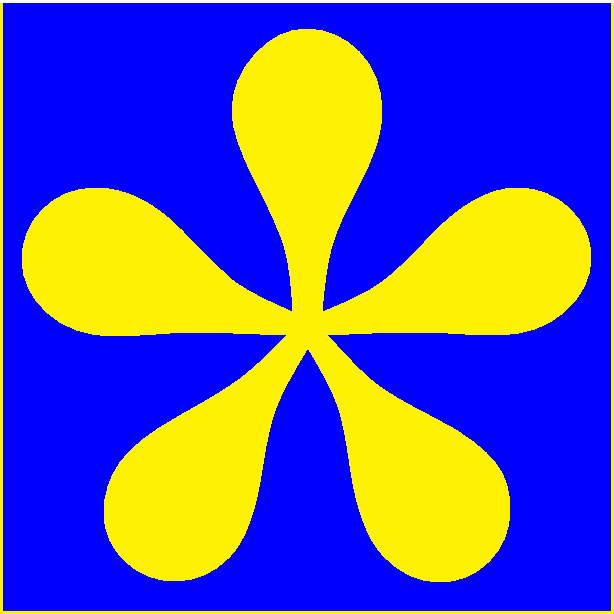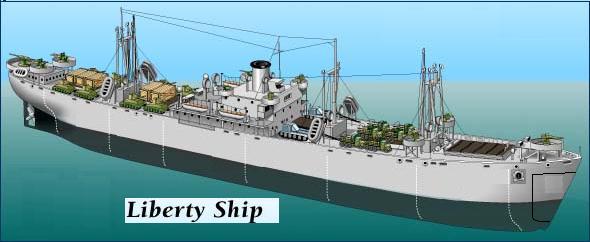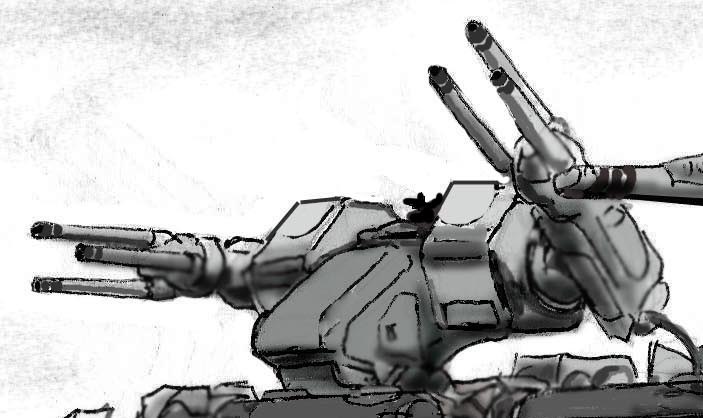
Plenipotentiary Council. | Liberty II-Class
Cargo Ship. | 
Plenipotentiary Council. |
|---|
A few surviving WWII Type 471 Cargo vessel documents survived, along with one non-operational example- The SS John Brown. Additionally, a WWII-era Landing Ship, Tank (LST, also called "Large, Slow Target") provided REF Reconstruction  | | A Typical Liberty II-Class Cargo Ship. |
|---|
Specialists with an idea- Combine the two vessel types, with the Liberties large and simple hull design, and the LST's bow doors. To this was added a modified version of the LST's loading ramp- Three floatable units, called "Alligators", would be joined by light semi-bridges, allowing the ships to anchor as much as 200 feet off-shore, far enough at sea to allow landing at all but the most rough coastlines (which could usually be routed around at less than 10 miles).The initial plan was to build 5 hulls at a time, launching them all at the same time. The hulls, essentially barges at this stage, would then be towed to a nearby pier, where engines, motors, superstructure, and a few hull components would be installed. All through hull fittings, including ship propeller, fathometer, and rudder, would already be installed, but a few key sections of decking would not be in place to allow the engines and etc to be easily installed. The "First Class" of 10 Liberty II's (5 at Alameda Shipyard, 5 more at Woolston, Southampton) were "wetted" 14 days after construction began- A mere month after construction was authorized.The hulls were no more than outfitted when the Invid returned; However, for reasons the Invid themselves can not explain, they didn't attack "The Ten", and further construction carried on with two additional sites being chosen: Kiel, Germany and Hampton Roads, Virginia.Of the 2,000 or so eventually built, only a few were named; SS John Perry (named for the First of the original Liberty ships), the First Liberty launched (hull AC-01, from Alameda), RMS EdWard The 18th (the First British hull launched), Duetchsland (the First German Liberty II), and SS Rolf Emmerson (the First Hampton Roads Liberty II), along with a few others. However, purchasers often named their ships after taking possession.Production of the Liberty II finally ended in 2102 on Terra, but many of these ships remain in service, and an oversized version created by cutting the bow off of one, the stern off another, and then splicing the two hulls together are fairly common (see Fraternity-Class Cargo Ship). Additionally, the UGC has underwritten production of version on other worlds, due to the low cost, to jump-start trade on those worlds. These include Pandora and Garuda, where special modifications had to be made to the design for environmental impact (specifically in terms of the docks andd piers).Name: Liberty II-ClassModel Type: 441 foot cargo shipClass: Cargo ShipCrew: Nominally about 50 to 75. Special and dangerous cargos may require more, between 100 and 150. Live animal cargos (such as cattle require about 150 to 200, depending on the type.Passengers: Nominally none; However, the Tango Sierra ("TS") variant IS equipped as a troopship, capable of carrying 1,000 power armored troopers, and some were converted to liners, capable of transporting 600 First class passengers in very basic accommodations.Major Variants:TS ("Tango Sierra"): Also refer to as 'tangos' and 'tangs', these were troopships (as discussed).PS ("Papa Sierra") : Also refer to as 'papas', 'pops', and Mark Twains (for the First of this variant), these were passenger ships (as discussed).Oilers: Also referred to as "Zippos" for their cargo, these carried fuel. Thousands of miles of steel fuel lines were installed to contain the fuel, both to prevent it sloshing around (which effects handling, especially in rough seas) and to contain damage if struck.Ammunition Carriers: Also referred to as "Mounts" or "cans". Additional armored bulkheads prevent explosions in one compartment from spreading as easily to another; WX deck hatches are designed to plow upWards in the event a magazine is struck.MB (MulBerries): Specially refitted hulls intended to be steamed to a location and sunk to create temporary, emergency harbors.For a fuller description of each variant, CLICK HERE.MDC By Location: |
Hull-
Pilot House-
Secondary Laser Turret (Head)-
Secondary Lasers (Head Lasers; 5)-
Turret Gunners Compartment-
Turret Upper Arms (2)-
Turret Laser Cannon Barrels (4)-
Turret MRM Launchers (2)- | 700
500
50*
25 each*
300*
150 each*
100 each*
150 each | Turret Gatling Gun- *
Turret Radar Array-**
Radar Unit-
Bow Doors (2)-
Bow Ramp Segments (3)-
Anchor Chains (2 bow, 2 aft)-
Mooring Cables (6 each side)-
| 100
100
300
300 each
200 each
250 each
200 each
|
| * Part of the M-16 turrets; Destroying the main body of the turets take these off-line.** Part of the M-16 turret; In addition to being effected by the turret damage, if it is damaged the turret looses +2 special bonus to strike.Speed & Statistical Data: |
Speed: 11 knots
Range: 11,000 miles. Can be refueled underway.
Length: 441 feet
Beam: 56 feet
Draft: 10 feet. Can be reduced to 6 for landing operations, but must be tied to another Liberty Ship at that time for stability.
Clearance: 40 feet.
Cargo: Up to 9,000 TONS of cargo can be carried.
| Power System: Hydro-Cell.
Drive Systems: Water Jet (sucks water in front, spits it out under high pressure and heat out the back).
Cost and Availability: 210,000 credits new and unarmed; 4-6 months to construct. The Ten were raced out to prove it could be done, but after that production was slowed.
Black Market: Not available. The Black Market isn't interested in selling them now or ever.
|
| Weapons Systems: |
|---|
1. Model-16 Anti-Aircraft Turret: Each vessel has 05 of these anti-aircraft turrets, one at the bow and one at each corner  of the superstructure. The turret is based on the torso of the MKD-401 Mecha Knight Destroid, and has 4 types of weapons: A pair of Laser Cannon "arms," "shoulder" missile launchers, a "belly" 20mm, 5-barreled Gatling guns for anti-missile defense, and a head laser turret. However, the PBC and MRM launcher were not kept due to cost concerns. SPECIAL BONUS: The turret has its own built-in fixed forward radar, giving it +2 to strike. Loss of this radar negates this advantage, but the guns and missiles can still be trained by information from the Combat Information Center.A) Laser Cannons (4): This is the main weapon of the turret. NOTE: These guns fire in tandem, like pom-pom guns. If one barrel is damaged, reduce the damage and rate of fire FOR THAT ARM by a Third. Each gun must be targeting the same object as the other (can not be independently targeted). of the superstructure. The turret is based on the torso of the MKD-401 Mecha Knight Destroid, and has 4 types of weapons: A pair of Laser Cannon "arms," "shoulder" missile launchers, a "belly" 20mm, 5-barreled Gatling guns for anti-missile defense, and a head laser turret. However, the PBC and MRM launcher were not kept due to cost concerns. SPECIAL BONUS: The turret has its own built-in fixed forward radar, giving it +2 to strike. Loss of this radar negates this advantage, but the guns and missiles can still be trained by information from the Combat Information Center.A) Laser Cannons (4): This is the main weapon of the turret. NOTE: These guns fire in tandem, like pom-pom guns. If one barrel is damaged, reduce the damage and rate of fire FOR THAT ARM by a Third. Each gun must be targeting the same object as the other (can not be independently targeted).
Purpose: Anti-Aircraft/Ship
MD: 2D10 short burst, 4D10 medium burst, or 6D10 long burst.
Rate of Fire: 8 short, 4 medium, or 2 long bursts per arm per melee per gunner's attacks per melee.
Range: 10 miles
Payload: UnlimitedB) MRM Launcher Shoulders (2): A pair of MRM launchers mounted at the approximate position as the shoulders.
Purpose: Anti-Ship/Aircraft
Missile Type: Medium Range
Rate of Fire: Volleys of 1, 2, 3, 4, 6, 12 or all 24 per gunners attacks per melee.
Payload: 24 per launcher (48 total); Reloading takes about 5 minutes for a full reload (10 missiles take about 1 melee).C) 20MM Vulcan Gatling Gun: This gun is actually automated. The gunner activates the weapon by flipping a red switch under a cover on the control panel. The gun can NOT tell friend from foe, only whether an object is closing with the ship and how fast it is moving. If it meets certain criteria, the gun fires, throwing a wall of lead that either shreds the missile OR causes it to prematurely detonate.
Purpose: Anti-Missile Defense.
MD: 5D6 per 10 round blast.
Rate of Fire: Up to 6 per melee.
Range: 6,000 feet
Payload: 6,000 rounds (600 bursts). Reloading takes 20 minutes.D) Defensive Head Lasers (5): The same as the VF-1 Zulu Head Assembly; Though the Zulu would not be used on the final VF-1 design, it was used in the M-16 AA Turret as it provide a little more power to target.
Purpose: Anti-Aircraft/Missile
MD: 1D6 per barrel; A total of 5 barrels are available.
Rate of Fire: per gunner's attacks per melee.
Range: 200 feet
Payload: UnlimitedE) Head Lasers: The M16 AA Turret uses the Zulu head used on the Mecha Knight, a five-barrel variant of the RDF VF-1 series head.
Purpose: Defense
MD: 1D6 MD per barrel used; 1, 2, 4, or all 5.
Rate of Fire: per pilot's attacks per melee.
Range: 200 feet
Payload: Unlimited.
Cost: 50,000 credits each.
Availability: Rarely available. | 2. Small Boats: Most Fraternity-Class ships carry a few small boats for salvage, abandon ships, to assist in mooring (during unusually difficult or non-existent ports), and other general purposes.
|
| Features: |
- ESM: Radar Detector. passively detects other radars being operated.
- Radar: Combat grade radar. Range 100 miles, can track up to 50 individual targets. 95% reliability (24% against unfriendly stealthed vehicles).
- Blue Force Tracker: Identifies friend from foe. Overlays the information on both the radar and HUD, ensuring that friendly forces are not accidentally targeted.
- GPS: Standard tracking device. Ties into the Blue Force Tracker.
- Anti-Jamming System: Reduces Electronics Countermeasure by 3/4 (decrease skill level appropriately).
- HUD: Displays maps, radar, targeting information, and any OTHER information the wearer wants directly in front of the user.
- Virtual Map: Displays a continuously-updating map of local terrain for the pilot. Takes data from and gives data to other friendly units in the area. Effective land navigation of 85% as updates come. Good to 500 miles. Specific range can be adjusted in 1 mile increments.
- Loudhailer: Used to communicate verbally to other vessels. Where the 1 MC works for internal announcements and can be heard on the weather decks, the loudhailer can ONLY be heard by other vessels (and at that, only ones more or less directly in front of the vessel, or less than 50 feet away at the sides; It can not be heard astern).
- Video Camera: Records from the HUD. 50 hours of recording available.
| - Full Range Optic Sensory Suite: Infrared, ultra violet, Magnification, night sight, color filters, thermal imager. Range is about 200 miles for MOST sensors.
- Survival Pack: A pack of simpler emergency survival supplies: pup tent, sleeping bag, black light, GPS, First aid kit (bandages, gauze, bandage tape, pads, antiseptic/analgesic), plasma torch (for small repairs and starting fires), repair kit (with MDC Repair Spray), sewing kit (a small spool of thread and 5 needles), 7 star flares (250 foot apogee), 2 white parachute flares (1,500 foot apogee), 100 feet of black or brown parachute cord (150 lbs tensile strength), inflatable life vest (with auto-inflators), 2-5 days rations, 2 gallons water, water purification kit- good for about 10 gallons. Each man is REQUIRED to keep his "abandon ship kit" on his person or close to hand at all times.
- Liferafts: Every ship carries one 20-man per every 10-man onboard. The vessel need not be surfaced to deploy the liferafts; They will automatically release themselves at a depth of 250 feet.
- Smoke Dispensers (8): Throws out smoke flares capable of obscuring IR and heat sensors, and defeats visual tracking of the vehicle. Mostly used for escape and to cover retreating forces.
- Anchors (3): The ships are equipped with 3 anchors, two on the bow and one on the stern; This allows them to absolutely hold their position, not moving laterally or forward/aft.
|
Combat Bonuses from Liberty-Class Combat Elite:- 1 additional attack per melee.
- One additional Attack Per melee at levels 2, 4, 6, 8, 10, and 12 with any additional bonuses for the pilot.
- +2 Initiative
- +2 strike (any target)
|


 of the superstructure. The turret is based on the torso of the MKD-401 Mecha Knight Destroid, and has 4 types of weapons: A pair of Laser Cannon "arms," "shoulder" missile launchers, a "belly" 20mm, 5-barreled Gatling guns for anti-missile defense, and a head laser turret. However, the PBC and MRM launcher were not kept due to cost concerns. SPECIAL BONUS: The turret has its own built-in fixed forward radar, giving it +2 to strike. Loss of this radar negates this advantage, but the guns and missiles can still be trained by information from the Combat Information Center.
of the superstructure. The turret is based on the torso of the MKD-401 Mecha Knight Destroid, and has 4 types of weapons: A pair of Laser Cannon "arms," "shoulder" missile launchers, a "belly" 20mm, 5-barreled Gatling guns for anti-missile defense, and a head laser turret. However, the PBC and MRM launcher were not kept due to cost concerns. SPECIAL BONUS: The turret has its own built-in fixed forward radar, giving it +2 to strike. Loss of this radar negates this advantage, but the guns and missiles can still be trained by information from the Combat Information Center.